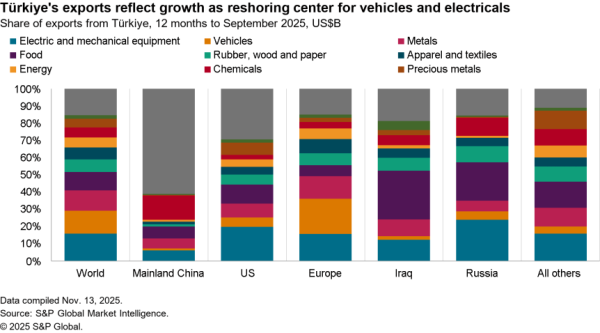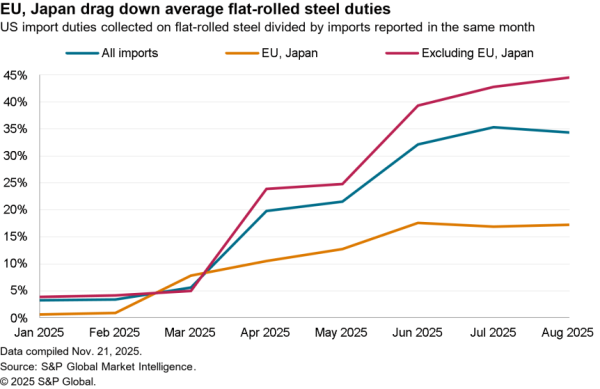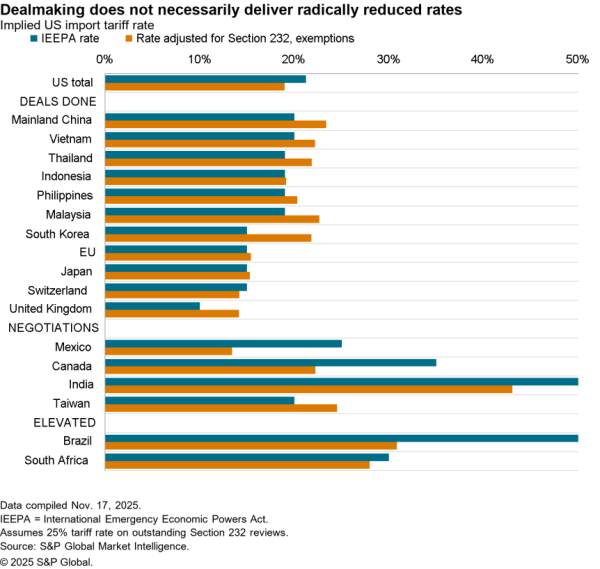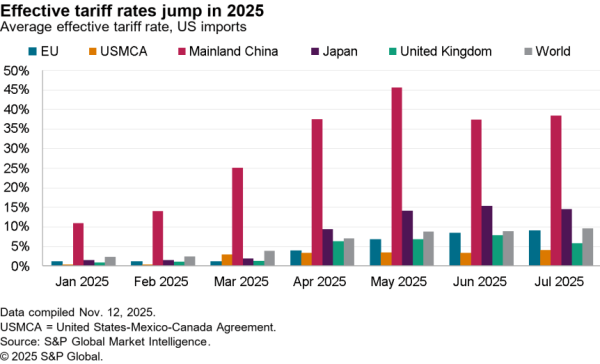Key findings this week
– Ford’s electric vehicle supply chain is expanding rapidly but faces operational and sourcing challenges.
– The consumer goods industry, particularly the toys industry, has an inventory problem and trade activity has fallen as a result.
– Foxconn is the latest electronics firm to expand its footprint in Vietnam.
Fording the EV gap: Building out battery supply chains

Ford plans to build a new electric vehicle (EV) battery plant in Michigan. The plant will use the lithium-iron phosphate technology from Contemporary Amperex Technology Co. Ltd. (CATL) and will come online from 2026.
– The plant may simplify Ford’s access to U.S. government funding under the Inflation Reduction Act, which requires 80% of the value of vehicles to come from the U.S. or a free trade partner from 2026 onward.
– Ford has been manufacturing the F-150 Lightning truck in the U.S. and the Mustang Mach-E in Mexico. S&P Global Market Intelligence Panjiva data show that Mexican exports of the Mustang Mach-E vehicle to the U.S. were worth $3.3 billion in 2022.
– Ford’s EV manufacturing has recently faced a few challenges. For example, the company has recently halted F-150 production because of “a potential battery issue” found at the predelivery phase.
– Automotive batteries accounted for 21% of total U.S. lithium-ion batteries in Q4 2022 after registering growth of 127% year over year. All other batteries—for electrical and electronic devices—increased by 51% over the same period.
– CATL has already ramped up its supplies to the U.S. The company was the largest seaborne shipper of lithium-ion batteries to the U.S. in January 2023 with 1,900 20-foot-equivalent units (TEUs) of deliveries associated with the firm. That put it ahead of Samsung SDI’s 497 TEUs and LG Chem’s 641 TEUs.
– Separately, General Motors Co. (GM) and GlobalFoundries have signed a long-term chip supply agreement whereby GlobalFoundries will directly supply GM’s tier-1 suppliers. GM has sought a “resilient supply of critical technology.”

The U.S. is not the only market receiving new investments in EV supply chains. Nissan and Renault will invest $600 million to develop two EVs and four internal combustion engine (ICE) models in Chennai, India.
– The development coincides with the recent discovery of lithium resources in India, with resources of 5.9 million tons identified. It is not yet clear whether processing and battery production will follow, although the Indian government has previously supported inward investment in electronics manufacturing.
– The top-three exporting territories of lithium carbonate and hydroxides accounted for 87% of exports in 2021, led by Chile with a 51% share.
– The density of resource availability across EV batteries, including lithium and rare earth materials, has prompted the U.S. and the EU to discuss forming a “critical minerals buyers’ club.”
– Despite the rising demand for lithium, supply may keep pace. S&P Global Market Intelligence price forecasting indicates that prices of Chinese lithium carbonate ex-works are set to fall by 21% in Q4 2023 versus Q4 2022.

Lithium miner Albemarle Corp. forecasts sales growth of 55%-75% in 2023, including increased demand for lithium, as it expects the “moderation in Chinese EV demand to be short-lived,” leading to a 40% rise in EV sales. The firm expects to expand its lithium production globally but is now focused on Australia, Chile, and the U.S.
– China dominates purchases of lithium from Chile, representing 68% of exports by SQM and 31% of those by Albemarle in the 12 months to Oct. 31, 2022. The figures compare with 16% and 12%, respectively, in 2018.
Consumer goods: Plenty more toys in the box

Toymaker Hasbro Inc. reported a 17% year-over-year decline in revenues in Q4 2022. The company also expects industry sales to be “flat to declining” in 2023. The firm’s gaming cards business improved despite “significant supply chain disruptions” linked to paper stock availability that the company will resolve for 2023.
– Hasbro’s inventory-to-sales ratio in Q4 2022 increased to 40% from 27% a year earlier and the Q4 average for 2011-2019 of 26%. Competitor Mattel Inc. reported a 64% ratio compared with the 2011-2019 average of 44%.
– U.S. seaborne imports linked to Hasbro fell by 55% year over year in Q4 2022, according to S&P Global Market Intelligence Panjiva data, before decreasing by another 38% in January 2023. Shipments linked to Mattel dropped by 17% in Q4 2022 and by 42% in January 2023.
Other consumer goods companies have also experienced rising inventories. For example, Spectrum Brands Holdings Inc. has noted plans to “still liquidate large amounts of high-cost inventory at aggressive prices” in the Q1 2023. The firm has a diverse portfolio of well-known brands, such as Remington and Russell Hobbs.
– Total U.S. retail inventories as a proportion of sales reached 126% in December 2022, the highest level since the start of the COVID-19 pandemic. The ratio for furniture and electricals reached 168%, the highest level since December 2013, excluding the pandemic.
– Some of those increased inventories may already be sold. U.S. retail sales rose by 3% sequentially in January 2023 after having fallen for two straight months. Sales growth was widespread, including a 4% rise in sales of furniture and electronics/appliances.

The government of the Malaysian state of Sarawak wants to double its exports of furniture by 2030 to 6 billion ringgit ($1.6 billion). The objective is to move up the manufacturing value-added ladder using wood that is currently exported on a raw or semi-processed basis.
– At the national level, wooden furniture accounted for 48% of exports of wood and related products from Malaysia in the 12 months to November 2022. This was an improvement from 34% in 2016. However, the improvement has been in part due to raw wood exports falling by 4% annually, while furniture increased by 7% annually.
Technology: Another win for Vietnam

Hon Hai Precision Industry (Foxconn) may open a new factory in Vietnam to produce MacBook computers for Apple. That would expand the range of Apple products manufactured in Vietnam, which has so far focused on peripherals.
– Vietnamese exports of computers and telecoms equipment reached $83 billion in the 12 months to Nov. 30, 2022. The longer-term growth may reflect reshoring from mainland However, the total is down from the 2021 peak owing to reduced demand in the wake of the pandemic.
– Shipments were led by Samsung Electronics Co. Ltd., which accounted for 63% of exports in the past 12 months, followed by LG Electronics. Luxshare and Compal are building up rapidly.
– Manufacturing of mobile phones in Bangladesh reportedly fell by 43% year over year in H2 2022, partly reflecting reduced demand linked to the weak economy. Most phones are used domestically rather than exported.

Set-top box maker Roku suffered an 18% year-over-year decline in device revenues in Q4 2022, while inventories more than doubled. The firm’s margins also decreased, in part owing to “higher costs caused by inflationary pressure and supply chain disruptions that continue to elevate certain component costs.”
– S&P Global Market Intelligence’s supply chain data show that U.S. seaborne imports linked to Roku fell by 18% year over year in Q4 2022. However, there are signs of a marked rebound, with growth of 165% in January 2023 potentially reflecting supply chain debottlenecking.
– Shipments from Vietnam linked to Roku increased to 32% of the total in Q4 2022, up from 14% in Q4 2021 and 0% before 2018. Imports from China fell to 49% in Q4 2022 from 78% a year earlier, while shipments from Thailand reached 12%.
– Cisco Systems Inc. reported a 7% increase in revenues, partly reflecting “an improving supply situation.” The firm has spent several quarters going through a process of “product redesign, with qualifying alternative components, with working with our [the company’s] suppliers to get to their subcomponents.”
Japan’s exports of technology products remained weak in January 2023. Exports of semiconductors rose by just 0.4% year over year, while exports of semiconductor machinery fell by 11.9%. Capital goods and autos performed better, with exports jumping 14.9% after a year of manufacturing interuptions.
Industrials: Mexican steel expansion ahead

Steelmaker Ternium SA may build a $2.2 billion steel mill in Northern Mexico with a production capacity of 4.7 million tons per year. The capacity may be used for the auto industry in Mexico and exported to the U.S. and Canada.
– S&P Global Market Intelligence Panjiva data show that Ternium was the largest exporter of steel products from Mexico in 2022, with 2.97 million tons shipped, despite experiencing a decline in shipments during the year. Exports linked to Ternium had fallen by 24% year over year in Q4 2022.
– European steelmaker Thyssenkrupp AG has noted that “in January ongoing restocking by our customers that will most likely gain momentum going forward.” The firm is also “improving demand and hence increasing shipments” for its steel products and car components.
– U.S. steelmaker Cleveland-Cliffs Inc. sees the automotive sector as a major driver for steel demand in 2023. The company has stated, “Our January auto steel shipment rate was its best in nearly a year, and we expect this momentum to continue throughout 2023.”

India may reverse its restrictions on imports of solar power generating equipment. The potential relaxation is designed to encourage investment to meet renewable energy targets. They were originally put in place to encourage manufacturers to set up factories in India.
– S&P Global Market Intelligence bill of lading data show that Indian imports of all solar power equipment products dropped by 73% year over year in the three months to Nov. 30, 2022. Shipments from mainland China and Hong Kong SAR accounted for 86% of imports in the past 12 months and lost out in the latest downturn to supplies from Thailand.
The European Commission is planning new sanctions against €11 billion worth of exports of technology and industrial goods to Russia. The products targeted will include components for truck and jet engines as well as electronics and construction equipment. Dual-use restrictions will also be extended so that the EU will “have banned all tech products found on the battlefield.”




